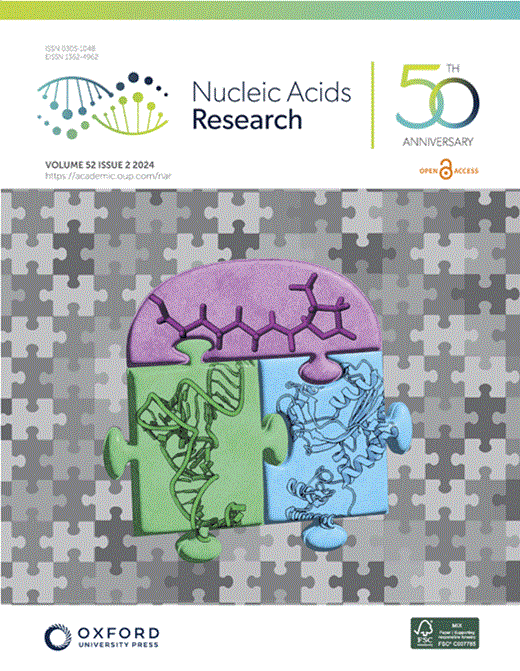Naphthalene diimide-naphthalimide dyads promote telomere damage by selectively targeting multimeric G-quadruplexes
IF 16.6
2区 生物学
Q1 BIOCHEMISTRY & MOLECULAR BIOLOGY
引用次数: 0
Abstract
G-quadruplex (G4) nucleic acid ligands have attracted significant attention as putative anticancer agents for selectively stabilizing telomeric structures. In our pursuit of targeting the most biologically relevant telomeric structures, we have investigated a new class of naphthalene diimide (NDI)-based ligands designed to bind multimeric G4s. The NDI unit covalently linked with one 1,8-naphthalimide (NI) moiety, results in ligands able to fold into a sandwich-like conformation fitting into the binding pockets of telomeric multimeric G4s, thus optimizing binding complementarity. Varying the NDI decorations, we synthesized a small library of NDI-NI dyads and then examined their capability of stabilizing G4s by biophysical assays. Given the relevance of G4 stabilizing agents in fighting cancer, the most promising NDI-NIs were evaluated for their antitumoral activity on a panel of human cell lines originating from different tumor histotypes. Obtained results evidenced that three of the selected ligands promoted an accumulation of telomere-localized damage leading to a robust impairment of cell viability, regardless of homologous recombination status. These data, then confirmed in advanced 3D models, paved the way for the advancement of NDI-NIs as a new class of clinically relevant antitumoral agents. Finally, computational analyses gained deeper insight into their binding modality.萘二亚胺-萘酰亚胺双体通过选择性靶向多聚g -四聚体促进端粒损伤
g -四重体(G4)核酸配体作为一种选择性稳定端粒结构的假定抗癌剂引起了人们的极大关注。在我们追求最具生物学相关性的端粒结构的过程中,我们研究了一类新的基于萘二亚胺(NDI)的配体,旨在结合多聚体G4s。NDI单元与一个1,8-萘酰亚胺(NI)片段共价连接,导致配体能够折叠成三明治状构象,适合端粒多聚体G4s的结合袋,从而优化结合互补性。通过改变NDI修饰,我们合成了一个小的NDI- ni二偶体库,然后通过生物物理实验检测了它们稳定G4s的能力。鉴于G4稳定剂在抗癌中的相关性,最有希望的NDI-NIs在来自不同肿瘤组织型的人类细胞系上的抗肿瘤活性进行了评估。获得的结果证明,无论同源重组状态如何,所选择的三种配体都促进了端粒局部损伤的积累,导致细胞活力的严重损害。这些数据随后在先进的3D模型中得到证实,为NDI-NIs作为一种新的临床相关抗肿瘤药物的发展铺平了道路。最后,通过计算分析更深入地了解了它们的绑定模式。
本文章由计算机程序翻译,如有差异,请以英文原文为准。
求助全文
约1分钟内获得全文
求助全文
来源期刊

Nucleic Acids Research
生物-生化与分子生物学
CiteScore
27.10
自引率
4.70%
发文量
1057
审稿时长
2 months
期刊介绍:
Nucleic Acids Research (NAR) is a scientific journal that publishes research on various aspects of nucleic acids and proteins involved in nucleic acid metabolism and interactions. It covers areas such as chemistry and synthetic biology, computational biology, gene regulation, chromatin and epigenetics, genome integrity, repair and replication, genomics, molecular biology, nucleic acid enzymes, RNA, and structural biology. The journal also includes a Survey and Summary section for brief reviews. Additionally, each year, the first issue is dedicated to biological databases, and an issue in July focuses on web-based software resources for the biological community. Nucleic Acids Research is indexed by several services including Abstracts on Hygiene and Communicable Diseases, Animal Breeding Abstracts, Agricultural Engineering Abstracts, Agbiotech News and Information, BIOSIS Previews, CAB Abstracts, and EMBASE.
 求助内容:
求助内容: 应助结果提醒方式:
应助结果提醒方式:


